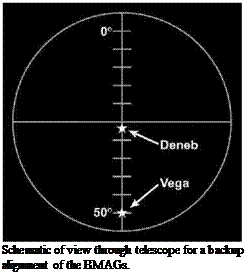Set stars: backup attitude reference and other comments
Down the side of the PAD form was an area for comments that related to the burn, and in particular the set stars. As ever, the Apollo planners had looked for procedures and methodologies that would give the crews options to continue in the face of equipment failure. The set stars were to provide a backup attitude reference in ease the guidance platform failed to remain aligned to the desired RBBSMMAT.
Although it w’as something of an alphabet soup, the basic idea went like this. As well as the I M lJ with its gyro-stabilised platform, the spacecraft had two other sets of gyros: the body-mounted attitude gyros (BMAGs) and their associated electronics, the gyro display couplers (GDCs) that made sense of their output. Unlike the platform, which measured absolute attitude, the BMAGs really only measured changes in attitude. Therefore to determine absolute attitude, the GDCs had to work from a starting point and count the changes in attitude as measured by the BMAGs. It wasn’t as accurate as the IMU and was prone to drift but it would work for short periods. Normally, the GDCs got their starting point from the IMU merely by a press of the GDC Align button. But if the platform was lost, another way w’ould be needed to give the GDCs a valid starting point. Then, by processing the signals from the BMAGs. they could determine absolute attitude relative to the desired REFSMMAT. The aim of the set stars was to give the GDCs that starting point.
What mission control did was to give the crew two stars – in this Apollo 15 ease, Vega and Deneb – and a set of three attitude angles. To make the backup realignment work, the CMP needed to manoeuvre the spacecraft so that the stars were arranged in the scanning telescope in a predefined manner. This placed the spacecraft in a known attitude. In that attitude, the three given angles represented the spacecraft’s attitude with respect to the desired RBFSMMAT. enabling the
BMAGs and GDCs to work from that attitude as their starting point.
 Fortunately, no IMU ever failed in flight and this procedure was never used.
Fortunately, no IMU ever failed in flight and this procedure was never used.
The next comment in the PAD – No ullage – reminded the crew that because the SPS propellant tanks were full there was no need to settle their contents prior to the burn.
When there was a need, an ullage burn by the RCS thrusters forced propellant to the outlet end of the tanks to minimise the possibility of gas from the empty part of the tank being ingested into the engine.
After stating the mass of the lunar module, the comments went on to deal with the problems pertaining to Apollo 15’s faulty circuitry in the primary control bank of the SPS engine. If they could only use the good В bank, the slightly reduced thrust would increase the burn duration by 11 seconds to 6 minutes 52 seconds. It was decided, however, that the crew should let the burn begin under automatic control with the В bank, and then after several seconds manually engage the A bank. Shortly before the expected cutoff, they would disengage the A bank and let the automatic systems terminate the burn with the good bank, lest the short circuit in the A bank override the shutdown command.
The final point in this PAD was that should the В bank itself fail, the crew were to use the A bank manually to achieve the required delta-v and enter lunar orbit. In this case, they would have had to ensure shutdown by the simple expedient of removing power from the SPS which they would have achieved by pulling a circuit breaker.
This lengthy PAD demonstrates how, even on what was considered a ‘nominal’ flight, great lengths were taken by mission control and the crew to provide options to successfully pursue the mission in the face of a wide range of possible failures.










